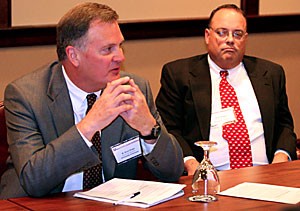Representatives from nine major universities near the U.S.-Mexico border will pursue a joint initiative to research and provide education on the effects of border control policies on a local and national scale, officials announced yesterday at the Common Defense Forum Conference on Border Security Cooperation.
From engineering to economics, different areas of expertise will join in the Southwest Border Security Consortium, an effort to maintain a nonbiased but powerful voice for the nation concerning border-control issues.
Universities in Arizona, Southern California, New Mexico and Texas are part of the consortium, which hopes to become a national resource with expertise in many areas, said Bob Welty, director of homeland security projects at San Diego State University.
The consortium, which will act as a think tank, hopes that Congress will eventually approach the group with issues concerning the region in effort to find the best solutions.
The project is only a year old, so the consortium is still in its first steps, but “”a number of opportunities are being pursued,”” said Bill Stockton, associate director and research engineer at Texas A&M University.
In order to develop technology and more jobs in Mexico, a primary focus of the consortium is to establish relations with Mexican universities, said Bruce Wright, associate vice president for economic development at the UA.
“”More people will go to Mexico from the U.S. because of developing technology (in Mexico), and the wall will be irrelevant,”” Wright said, referring to the 700-mile wall that is being planned for the U.S.-Mexico border.
The use of technological surveillance to follow the movement of diseases such as influenza across the Southwest region is another major focus of the consortium, said Eric Frost, director of the homeland security master’s program at San Diego State University.
The Southwest Border Security Consortium hopes to get students from all the universities involved in the process, specifically in terms of researching solutions to the secondary effects the wall may have on local communities, Frost said.
Stockton said the Southwest U.S. already maintains joint activity with Mexico in terms of environment, water, social issues and language, which makes it easier to work with Mexico on the project.
Although it hopes to gain state and federal financial support, for now, the Southwest Border Security Consortium is funded by “”sweat equity,”” said Rick Shangraw, associate vice president for research at Arizona State University, referring to the individual work done by group members.









